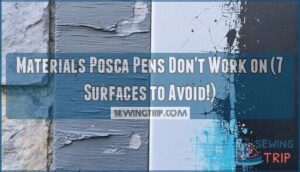This site is supported by our readers. We may earn a commission, at no cost to you, if you purchase through links.
 You’ll find that materials posca pens don’t work on include rough stone, unprimed canvas, greasy surfaces, flexible rubber items, and human skin.
You’ll find that materials posca pens don’t work on include rough stone, unprimed canvas, greasy surfaces, flexible rubber items, and human skin.
These surfaces either repel the paint or don’t provide proper adhesion. Oily surfaces cause the ink to bead up and slide off, while textured materials like rough stone prevent smooth application.
Unprimed canvas absorbs the paint unevenly, creating blotchy results. Flexible materials like shoes and squishies crack when bent.
Chalkboards often reject the paint entirely. Think of it like trying to write on a wet window – the ink just won’t stick where it should, leading to frustrating results and wasted creativity.
Table Of Contents
Key Takeaways
- You’ll waste your time and pens on rough stone, unprimed canvas, greasy surfaces, flexible rubber items, and human skin since these materials either repel the paint or don’t provide proper adhesion.
- Your artwork won’t last on shoes, squishies, and leather because the flexible nature causes cracking and flaking, while the materials’ natural properties prevent the water-based ink from bonding correctly.
- You can’t rely on chalkboards for temporary art since their porous surface absorbs the pigment permanently, creating stubborn stains that won’t wipe away cleanly like they should.
- You’ll get better results by choosing appropriate surfaces like primed canvas, smooth wood, glass, plastic, and metal instead of fighting materials that naturally reject water-based acrylic paint.
Rough Stone
Rough stone surfaces spell trouble for your Posca pens.
The porous, uneven texture creates serious limitations that’ll frustrate any artist.
Your pen tips face excessive pen wear as they catch on ridges and divots.
The surface texture prevents proper ink adhesion, causing paint to pool in cracks and create an uneven finish.
For better results on other materials, consider how paint adhesion properties affect the outcome.
Instead of fighting these surfaces, choose material alternatives like smooth river rocks or polished stones.
Save your Posca pens for materials that actually work with their water-based formula.
This will help prevent excessive pen wear and ensure proper ink adhesion, leading to a more even finish and less frustration for the artist, while also considering the impact of paint adhesion properties.
Unprimed Canvas
Canvas without primer creates a challenging surface for Posca pens. The porous, untreated material absorbs acrylic paint unevenly, causing bleeding effects that ruin clean lines.
Your artwork suffers from poor acrylic adhesion, leading to paint flaking over time. Applying Gesso can help with canvas preparation.
Here’s why unprimed canvas doesn’t work well:
- Bleeding Effects – Ink spreads unpredictably across fibers
- Paint Flaking – Colors chip off without proper foundation
- Primer Importance – Missing base coat prevents stable adhesion
- Canvas Preparation – Raw materials need treatment first
Always prime your canvas before using these markers.
Greasy Surfaces
Oil and water don’t mix – neither do Posca pens and greasy surfaces. Your markers will bead up like raindrops on a waxed car, creating frustrating adhesion issues that’ll make you want to toss your pens across the room.
Your Posca pens will slide around like they’re ice skating on butter – absolutely zero grip whatsoever.
For dealing with such issues on nylon, it’s important to remember to pre-treat grease stains.
| Surface Type | Problem | Solution |
|---|---|---|
| Kitchen counters | Paint beads and slides | Degrease with dish soap |
| Car hoods | Zero adhesion | Use automotive primer |
| Cooking utensils | Ink won’t stick | Clean thoroughly first |
| Oily wood | Patchy coverage | Sand and prime surface |
| Greasy metal | Paint flakes off | Apply alcohol-based cleaner |
Proper surface preparation and cleaning methods transform stubborn greasy surfaces into perfect canvases for your creative projects.
Shoes & Sneakers
Despite the temptation to customize your favorite kicks, shoes and sneakers present unique challenges for Posca pens. Most footwear materials simply don’t play nice with water-based acrylic paint. Synthetic materials like patent leather and rubber-heavy soles reject the ink, causing it to bead up or flake off with wear.
Fabric sneakers offer your best shot at success, but even canvas shoes need proper shoe preparation. Clean the surface thoroughly and apply a primer base coat for better adhesion. Without this prep work, your artwork won’t last through daily wear.
Design durability depends heavily on sealing techniques. A clear acrylic finisher spray protects your work from scuffs and weather. However, high-friction areas like toe boxes and heel counters will still show wear over time. For permanent customization, consider professional-grade paints instead of Posca pens on footwear surfaces. These pens contain pigment paint with a mixing ball inside, which is a key factor in their performance and durability, especially for daily wear and customization purposes, requiring a good clear acrylic finisher spray.
Squishies
Squishy toys present major challenges for Posca pens due to their unique material properties.
**Soft, flexible surfaces and acrylic paint don’t mix – your artistic dreams will literally crack under pressure.
These flexible surfaces cause serious adhesion problems, leading to ink cracking and paint absorption issues that compromise design longevity.
When you squeeze these toys, the acrylic paint develops fissures and eventually flakes off completely.
The porous material absorbs the ink unevenly, creating blotchy results that worsen with use.
**Soft foam usage is key to achieving the desired squishiness in these toys.
Problematic squishy surfaces:
- Stress balls: Cracking and peeling during compression
- Memory foam items: Smudging and bleeding through material
- Slime toys: Clumping and rapid fading
- Kitchen sponges: Excessive absorption and spreading
- Play foam: Flaking and rubbing off with handling
Leather
Leather presents a tricky challenge for Posca pens due to its flexible nature and varying surface textures.
Most leather types resist proper adhesion, causing ink fading within weeks of application. The porous surface absorbs moisture unevenly, preventing the acrylic paint from bonding correctly.
Leather preparation with primers helps slightly, but sealing leather afterward still doesn’t guarantee permanence. The material’s natural oils create barriers that repel water-based inks.
Professional leather-specific materials work better than Posca pens on these demanding surfaces. For best results, select paints that offer optimal adhesion and durability, ensuring optimal adhesion and a longer-lasting finish with durability and proper adhesion.
Chalkboards
Moving from leather’s unpredictable results, chalkboards present an even trickier challenge for your Posca pens. These traditional classroom surfaces spell trouble through pigment absorption that makes your artwork nearly impossible to remove.
Chalkboards feature porous surfaces that drink up Posca ink like a sponge. Unlike nonporous surfaces where your pens shine, these boards create permanent stains. The texture challenges don’t stop there – chalk residue mixing with your fresh pigments creates muddy, unpredictable colors that ruin your design.
One issue might be that the Posca pens are watery, further exacerbating the problem on porous surfaces.
Removal difficulty becomes your biggest headache. What should wipe away easily becomes a stubborn ghost image. You’ll scrub and scrub, but traces remain embedded in the board’s porous surface structure.
Skip chalkboards entirely for Posca projects. Instead, grab liquid chalk markers designed specifically for these surfaces. They’ll give you the coverage you want without the permanent commitment. Save your Posca pens for smoother, nonporous surfaces where they truly perform their best.
Frequently Asked Questions (FAQs)
Why are my POSCA pens not working?
Your POSCA pens mightn’t work on greasy, wet, or rough surfaces like unprimed canvas, oily materials, or textured stone. Clean the surface, let it dry completely, and test first.
Do POSCA pens work on material?
Most materials work great with POSCA pens, but you’ll struggle with rough stone, wet surfaces, greasy materials, and flexible items like rubber.
They excel on glass, plastic, metal, canvas, and paper for vibrant, lasting results.
Can Posca markers be used on anything?
While versatile on glass, metal, and plastic, you can’t use Posca markers on everything.
They struggle with rough stone, wet surfaces, greasy materials, and flexible items like rubber toys where the ink won’t properly adhere to create a lasting mark, particularly on flexible items.
What surfaces do POSCA pens work on?
You’ll find these acrylic markers excel on non-porous surfaces like glass, plastic, metal, and canvas. They’re perfect for decorating lunch boxes, skateboards, fabric, and smooth wood without chipping or fading.
Do Posca pens work on window glass or mirrors?
Yes, you’ll have great success using Posca pens on window glass and mirrors.
These non-porous surfaces allow the acrylic paint to adhere beautifully, creating vibrant, opaque designs that won’t chip or fade easily.
Do Posca pens work on wet paper?
No, you shouldn’t use Posca pens on wet paper.
The moisture causes ink bleeding, blurring, and poor adhesion.
Your artwork will spread uncontrollably and may flake off later.
Always let paper dry completely first.
Can you use Posca pens on skin?
Your skin deserves better than potential irritation or allergic reactions from Posca pens. These acrylic markers aren’t designed for human skin contact. Skip the risk and choose body-safe alternatives instead.
Will Posca pens stick to rubber surfaces?
Posca pens won’t stick properly to rubber surfaces.
You’ll likely experience smearing and poor adhesion since the water-based ink doesn’t bond well with rubber’s flexible, non-porous texture.
Try alternative materials instead.
Do Posca markers work on waxed wood?
Here’s where things get tricky with your art project.
Waxed surfaces create significant beading, causing your Posca markers to slide around like water on a duck’s back, preventing proper adhesion and coverage.
Can Posca pens write on Teflon cookware?
No, you can’t write on Teflon cookware with Posca pens.
Teflon’s non-stick coating repels the water-based acrylic ink, causing it to bead up and slide off rather than adhering to the surface.
Conclusion
Understanding materials posca pens don’t work on saves you time, money, and creative energy. These seven problematic surfaces—rough stone, unprimed canvas, greasy areas, shoes, squishies, leather, and chalkboards—simply won’t cooperate with your artistic vision.
Instead of wrestling with unsuitable materials, you’ll achieve better results by choosing appropriate surfaces like primed canvas, smooth wood, or quality paper.
Smart surface selection transforms your projects from disappointing experiments into successful masterpieces that showcase your creativity properly, and helps you avoid wasting time on surfaces that posca pens don’t work on, ultimately saving you time and money.
- https://bindingofisaacrebirth.fandom.com/wiki/Completion_Marks
- https://new.mta.info/agency/arts-design/collection/each-one-every-one-equal-all
- https://www.imdb.com/title/tt1527375/
- https://www.slideshare.net/slideshow/chalk-board-248573815/248573815
- https://www.rawlinspaints.com/blog/from-classrooms-to-cafes-creative-ways-to-use-blackboard-paint/










